25th October 2003
One of the big problems I've faced as my childhood fascination with dinosaurs has reawakened has been finding good books and avoiding duff ones - and there are oh so many of the latter out there! In the hope of helping anyone else in a similar position to pick their way through the minefield more successfully than I did, here a list of every dinosaur book I've ever bought, with my comments on them.They're listed on the order on which I read them, which is not necessarily the best order to read them in. For example, Gillette's Seismosaurus: The Earth Shaker is really too species-specific to read before you've got the more general background that books like Alexander's Dynamics of Dinosaurs and Other Extinct Giants can give you. C'est la vie.
In a desparate money-grubbing attempt to make my work on this site pay me something, I'm trying out the amazon affiliates program. If you buy any of the books on this page by following the links I've provided, I'll get a small cut. Or if you simply go to amazon via one of the links immediately below, I'll get a truly tiny slice of any money you spend on anything. Which would be nice.
Finally, please note that, apart from the Holtz-and-Rey encyclopedia at the bottom, all of these reviews are from 2003 or earlier. My ideas about some of these books have changed since then.
 Robert T. Bakker
Robert T. BakkerI bought this on a whim in, oh, let's see, it must have been about 1990 - certainly pre-Jurassic Park anyway. It's the book that re-awakened my interest in dinosaurs, portraying them as beautiful, elegant, powerful animals totally at odds with what was then the public image of dinosaurs. Specifically, it paints a picture of warm-blooded, fast-running, active dinosaurs: sauropods rearing on their hind legs, cracking their tails like whips, and so on.
The book presents convincing informal arguments, although it's very short on calculations that would lend weight to some of Bakker's specific conclusion (e.g. that T. rex could run at 40 mph.) But to my mind, that's not really important: the heart of this book is not an argument but an image: a reconstruction of dinosaurs that gives them a life they'd not had (for me anyway) before. This new image is built not only by the text, but also by Bakker's own gorgeous black-and-white illustrations.
Of course, a decade on, most of Bakker's ``heresies'' are now firmly entrenched as palaeontological orthdoxy. That might detract a bit from the raciness of the read, but it speaks well of Bakker's perception and determination to push views which, at the time, were not widely shared.
To my enormous irritation, my copy of this book has disappeared - either it got interred into a never-to-be-opened-again cardboard box when we moved house, or, more likely, I lent it to someone who never returned it. To add insult to injury, I can't easily get hold of a replacement: scandalously, it's been allowed to go out of print, in the UK at least.
Anyway, I may be ``remembering it through rose-coloured spectacles'', but I absolutely loved this book, whatever its scientific merits, and I'd unhesitatingly recommend it to anyone who loves dinosaurs. It's a ``popular'' book in the very best sense.
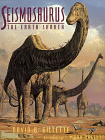 David D. Gillette, illustrated by Mark Hallett
David D. Gillette, illustrated by Mark HallettThis is an approachable analysis of a single specimen - the type of the eponymous Seismosaurus hallorum, a remarkably complete skeleton of a truly huge Diplodocus-like sauropod, measuring on the order of 150 feet from head to tail (at least according to Gillette, the discoverer and author - though some other authorities revise this estimate downwards.)
The book covers the story of ``Sam''s discovery, exhumation and preparation, as well as some informed speculation of how he came to be fossilised, and what he would have been like in life. Background material includes some detailed description of how fossils are formed and what parts of the original bone may survive; and these are sections on some unorthodox techniques used when trying locate bones: echo-location and dowsing, for starters!
This book's a little more technical than The Dinosaur Heresies - I'd not recommend starting with it. But if, like me, you like your dinosaurs big and tasty, this is an excellent detailed account of one of the biggest animals ever to walk the earth. Artwork is good too.
 Tim Haines
Tim HainesTo speak the brutal truth, this book is not particularly interesting. I was given it as a Christmas present in '99, along with the videos of the spectacular BBC TV series of the same name; and the videos really make the book redundant. The high-point of both is the visuals, and in fairness, the pictures in the book are wonderful: very believable photo-realism, gorgeous animals (of course), and impressive clarity. But it's so much more wonderful still to see the animated versions wandering across the TV screen.
One year after that Christmas, I was given the WWD wall calendar, which features exactly the same pictures as the book, but which makes more sense: it's nice having that Eustreptospondylus looking down at me from the kitchen wall.
As for the text in the WWD book: the bulk of it is transcribed natural history documentary - I don't know if it's actually the script from the TV programmes, but it's very similar in flavour if not detail. This means that it shares the programmes' fatal weakness that you can't tell what's fact, what's pure speculation and what's in between. Consequently, I've not read it all the way through.
The saving grace of the book is the sidebars, averaging maybe one a page, which contain a bit more background information on the animals covered in the main text, and are a tad more scientific. But even these don't go into much detail at all, and don't really ``spill the beans'' on the supposition - for example the Diplodocus ovipositor passes without comment.
All in all, you should save your money and get the videos instead.
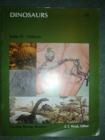 John H. Ostrom
John H. OstromThis is an amazingly dense little book. With just 32 pages, it feels more like a thick pamphlet than an actual book, but it packs an amazing amount into that little package. It covers definitions of what dinosaurs are and elementary taxonomy, discusses the debate over dinosaur metabolism, evaluates extinction hypotheses and more. The illustrations are functional rather than beautiful.
It's written by John Ostrom, one of the big names in paeleontology - perhaps best known as the discoverer of Deinonychus and re-opener of the metabolism debate in the sixties - so it can certainly be taken seriously!
To be honest, I probably didn't learn much from this book, but that's not the book's fault - it's just that I read it after other books which covered similar material. A snip at £3.50 in the UK (current price - YMMV), this is probably the best elementary introduction to dinosaurs that I've read.
 Christopher McGowan
Christopher McGowanI just don't know where to start with this one. I think it must be just about my all-time favourite book on any subject. McGowan is a lucid and compelling writer, who effortlessly brings clarity to any number of complex, potentially confusing issues.
The book opens with a brief discussion of properties of materials - exactly what's meant by strength, elasticity, toughness, and so on - and how this relates to the ability to dinosaur skeletons to bear weight. It goes on to discuss such matters as dinosaur metabolism (with a lot of very useful background material - what ``fitness'' actually is, for example), citing comparisons with various classes of extant animals; intelligence, with background material on the anatomy of the vertebrate brain; fluid dynamics, and how this influenced the ability of ichthiosaurs and pleisiosaurs to swim, and therefore what type of motion they probably used; and aerodynamics, with the obvious application to pterosaurs.
I'm sure I've missed all sorts here, but the point is that all of this is done in such an elegant way that, having reached the end of any given section, you're left immensely the better informed without any sense of having had to work hard to gain that understanding, and best of all, without having been patronised.
Unfortuntely, nothing is perfect. This book fails on just one respect for me, which is that towards the end, there's a chapter that just doesn't belong: a survey of all ichthyosaur species. It's clear that ichthyosaurs are McGowan's special interest, but - I'll say it quietly because I don't want him to hear - they're really, really dull :-) Seriously, I'm sure it's a perfectly good ichthyosaur survey, it just sticks out like a sore thumb from a book that's about dinosaur mechanics.
Anyway, if you have the slightest interest in dinosaurs, bio-mechanics, metabolism, fitness, fluid dynamics or frankly anything at all, treat yourself to a copy of this book! Buy two! But three! Give them to your friends!
(On sober reflection, my comments above look so enthusiastic that
someone's going to smell a rat, or think they do. So here's a sworn
statement that I have no stake in this book's success, have never
met or in any way communicated with the author, nor have any other
connection. I just love it - this is an unbiased but utterly
positive review.)
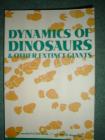 R. McNeill Alexander
R. McNeill AlexanderThis covers very similar subject matter to Dinosaurs, Spitfires and Sea Dragons, but it's a much smaller book - perhaps about a third as long in total. As with that book, I just love Dynamics - maybe I'm biased towards this kind of analysis, but the writing is good and concise, the figures (while basic) are clear, and the arguments are compelling.
There are at least two areas which Alexander goes into in more detail than McGowan: the first of these is the subject for which he is best known: that is, calculating dinosaur speeds from trackways. His formula for this - based only on stride length and footprint length - is widely used in some of the other books reviewed on this page, but here it is explained and applied in some detail. (Perhaps disappointingly, no tracks known to Alexander at the time of writing show dinosaurs moving very fast - certainly nothing like the ``cheetah speed'' attributed to Jurassic Park's suspiciously Deinonychus-like raptors - but you can't have everything.)
The other area which this book covers more closely than McGowan's is that of biomechanics: working out the specific stresses that would apply to various bones as dinosaurs moved, one application of which is figuring our theoretical top speeds. There's a closely worked example of a T. rex leg, which unfortunately peters out somewhere into a ``... but there are too many variable factors for us to reach firm conclusions'' sort of non-punchline, but the working is fascinating.
All in all, this is a wonderful book, and because of its smallish size, much less intimidating than most of the others reviewed here. I recommend it unreservedly.
 John R. Horner & Don Lessem
John R. Horner & Don LessemI don't remember this book as clearly as I should, because I absolutely devoured it in a weekend, after waiting for ages for it to arrive from an out-of-print stockist. (This after being lied to by both amazon.co.uk and alphabetstreet.co.uk about its availability: both accepted my order and waited around several days before emailing me to say, ``Actually we don't have your book! Ha ha! So what are you going to do? Sue us? Huh? Huh?'' Er, or words to that effect.)
Anyway: to the best of my knowledge, this is still the most comprehensive T. rex book out there, although it seems the rate of progress on this animal is so great that it might all be obsolete in a few more weeks (as I write this, the results of the full study of ``Sue'' are about to be released for peer review, and Chris Brochu is saying things like ``everything you know about T. rex is wrong.'')
It comes in several more or less disconnected parts: some background material on the history of T. rex's discovery; a fascinating survey of the different ways the animal has been reconstructed over the last hundred odd years; a walk through its skeletal anatomy, and some discussion about its probable lifestyle, including Horner's infamous claim that T. rex was possibly (I can't bring myself to say probably) a scavenger rather than a hunter.
Well, I loved it. If you can still find a copy, you should buy it; but I guess the next few years will see a rash of new T. rex books in the wake of the ``Sue'' discoveries and the five (Yes! Five!) new rexes that Horner's expedition has found this summer.
 Peter Dodson
Peter DodsonThe first thing that leaps out of this book is that it's written by someone who absolutely loves his subject. You can't miss it: Dodson's lunatic enthusiasm for ceratopsians permeates every page, and it's infectious.
This is good, because the book is pretty heavy going in places. Not that that's a bad thing, but I could have used a bit more interpretation as well as the dry facts - in fact, only a single chapter, right at the end of the book, investigates issues like posture (did the ceratopsians have semi-sprawled front legs?) and the function or functions of their neck frills. The great bulk of the book is spent in describing the known ceratopsian genera in some detail, with a lot of diagrams.
What made this book so good for me was that, while it's not afraid to use fearsomely technical language - the book is packed with lateroventral processes, occipital condyles and supracetabular thrickens - it never uses a term without explaining it in layman's terms first. This is wonderful for someone like me coming to the book from a position of ignorance: by the time I'd finished it, I didn't just know a lot about horned dinosaurs, I also now have some of the vocabulary I need to understand other technical material.
The best part of this book for me - though it may be old hat to more seasoned dino-fans - was the early chapter which walks closely through the entire skeletal anatomy of a typical horned dinosaur. I could almost feel my brain expanding as I absorbed all this carefully-explained anatomy. Wonderful.
I think that, having read and learned from this, I would now benefit from going back and re-reading Seismosaurus: The Earth Shaker with a firmer grasp of the necessary anatomy. I guess I can hardly pay The Horned Dinosaurs a higher compliment than to say that I not only enjoyed it, but I'm finding that it's enhanced my ability to enjoy other books.
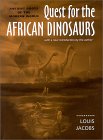 Louis L. Jacobs
Louis L. JacobsTo be brutally honest, this book was a big disappointment to me. There's nothing actually wrong with it as such, but it's not really a dinosaur book, which is what it sells itself as. Of the ten chapters, only two are really about dinosaurs - one on Malawisaurus, the most important and complete discovery to have come out of Jacob's work - and one on various other genera. The other eight chapters contain material on fossil mammals, crocodiles, fish etc, together with a lot of background material on Malawian history and culture, African independence in the sixties and so on.
To be fair, it's a good read, and there's a lot of interesting stuff here, but I was bargaining on more than 20% dino-content. There's some interesting stuff on the history of Titanosaur classification and how Malawisaurus material is helping to redefine knowledge of Titanosaur head shapes, but really, there is nowhere near enough of this, and far too much messing about with fossil mammals for my dino-centric tastes.
So I can't honestly recommend this book to the hard core dinosaur fan. But to be fair, this really is a matter of taste rather than a comment on the quality of the book. The prose is OK, the illustrations are adequate, I just want more dinosaurs already!
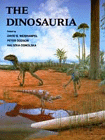 David B. Weishampel, et al.
David B. Weishampel, et al.Wow. Well, this arrived a few days ago, and I was a bit shocked to find an absolute tome - the word ``book'' doesn't really do it justice - of about the proportions of a telephone directory. It's eight hundred odd pages of brutally technical, utterly uncompromising detail. To the best of my ability to judge, this is as comprehensive a dinosaur book as you could wish to find. It includes descriptions and diagnostic features for all major taxa down to the genus level, with numerous diagrams illustrating details like the ways in which thigh-bone proportions vary among tyrannosaurids.
If you're looking for a book to teach you about dinosaurs, look elsewhere. It you know your stuff and you're looking for detail, this is the place to come.
One possible reservation. The most recent revision dates from 1991, and nine years is a surprisingly long time in paeleontology. For example, about a hundred and eighty new genera have been named in that time. So for truly up-to-the-minute information, the web may be a better long-term bet.
 Adrian J. Desmond
Adrian J. DesmondWell, this is certainly fascinating: a book built around the concept of endothermic dinosaurs, written a full decade before Bakker's Dinosaur Heresies. I found it in my local library, which isn't particularly up to date - but that's OK, it's nice to get a historical perspective on things every now and then.
The first couple of chapters are a leisurely review of paleontological history - something that's not covered often enough for my tastes. So if you want to see pictures of the original and now laughable Iguanodon, Megalosaurus and ``Laelaps'' restorations, if you're intrigued by the idea that Elasmosaurus's head was originally put on the wrong end of its body(!) and if you're interested in how the first sauropod to be discovered was misinterpreted as a whale, then this section is well worth a read.
What follows thereafter is a survey of some of the major groups of extinct animals, and the significance of hypothetical endothermy in them: the Permian pseudosuchians, then early dinosaurs, sauropods, birds and pterosaurs. The book closes with a discussion of extinction theories, notable chiefly because the bolide theory - which seems to be winning - doesn't even get a mention, for the simple reason that this book was written a decade before it was even proposed!
To be brutally honest, much of this book is already quite familiar: it suffers, like the Heresies, from its ideas having become orthodoxy. This is a tribute to its prescience, of course, but not necessarily a reason to read it today. All in all, unless you're interested in the story of early paleontology in the early chapters, this twenty-five-year-old book is, not unexpectedly, showing its age. It must have been astonishing in 1975, but in 2000 there are better books available. Worth reading for historical reasons.
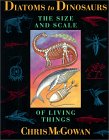
 Christopher McGowan, illustrated by Julian Mullock
Christopher McGowan, illustrated by Julian MullockThis covers much of the same material as the same author's Dinosaurs, Spitfires and Sea Dragons, but that's OK because I bought it in the hope of getting more of the same. It's more focussed on issues of size, which means that it gives much less space to things like muscle metabolism and the dynamics of soaring flight; but it talks in more detail about cube-square relationships, allometry and so on. It looks at problems such as the high blood pressure sauropods would have needed to feed blood to their brains, and discusses whether they might have had ``auxilliary hearts'' in their necks. (Executive summary: ``no.'')
I would be hard pressed to explain why, but while I liked this book a lot, I didn't find it as gripping as DS&S. I think it may simply be that I'm more familiar with the subject now, so reading it wasn't the same odyssey of discovery as the first book was. So there's a good chance that if I'd read them in the opposite order, this would get the rave review that I gave DS&S, and that would be getting this slightly lukewarm one.
In summary, everyone in the world should immediately buy one or other of these two books, but only real biomechanics nuts need both.
 Christopher McGowan
Christopher McGowanIt's worth saying why I chose to order this book. It's because of the positive impact of two of the others that I review above. Firstly, The Horned Dinosaurs left me with the feeling that understanding vertebrate mechanics in general would leave me in a much stronger position as regards the ability to make sense of dinosaur skeletons in particular. And secondly, Dinosaurs, Spitfires and Sea Dragons was just so insanely great that I'd cheerfully buy anything by McGowan in the sure and certain knowledge that it'll fascinate me.
In the event, when I finished reading it, I admit I was a little disappointed, not because there's anything wrong with it but because it covers a lot of the same ground as books I'd already read - particularly Dinosaurs, Spitfires and Sea Dragons, Dynamics of Dinosaurs and Other Extinct Giants and Diatoms to Dinosaurs. Maybe since the first and last of these are by McGowan, that shouldn't be such a surprise - clearly this is his favourite subject area.
This book's strength is very much in the mechanics. It concentrates much more on details like strength, stiffness, toughness (three different things!), friction, lift and drag forces, viscosity and suchlike. This is all covered very comprehensively with aid of simple but clear diagrams, and it's comprehensible to anyone with a bit of basic physics background. The principles are all illustrated by practical experiments for which instructions are given, together with sample observations.
So far, so good. Where I was left disappointed was in the absence of anatomy. In terms of actually walking through the vertebrate skeleton and learning how it's put together, there's less in this book than in the chapter of The Horned Dinosaurs that first captured my interest in this subject. What I'd been hoping for was a lot a skeletal diagrams compared and contrasted, with a lot more discussion of how the various animals are adapted for their behaviour. The book's failure to meet my expectations is of course not its fault, but mine!
In conclusion, this is an excellent book on basic mechanics and how it applies to vertebrates. It's not an anatomy book, but then it never promised to be.
If I was doing it all over again (substitute ``were'' for ``was'' in the clause if you're a subjunctive junkie) I think I would buy Dinosaurs, Spitfires and Sea Dragons and this book, and skip Diatoms to Dinosaurs, which seems to fall slightly between the two stools of concentrating on animals (as DS&S does) and on mechanics (as DtD does.) Any two of three make wonderful, informative, exciting reading; but all three is overkill.
 Martin Lockley and Christian Meyer
Martin Lockley and Christian Meyer
The brutal truth is that I haven't managed to make it past the first
few chapters of this book. It was recommended to my by one of the
leading dino-footprint guys, so I have no reason to think it's not
excellent. But I just can't excited about footprints in the absence
of their makers. Sorry.
 Ed. James O. Farlow & M. K. Brett-Surman
Ed. James O. Farlow & M. K. Brett-SurmanThis is absolutely the granddaddy of them all, the if-you-only-buy-one-book-buy-this-one of dinosaurs. It took me a while to get around to buying this because I was put off my the cartoonish cover. What a fool I was. I've learned more from this than from any other dinosaur book; more, in fact, than from most of the others put together.
It is packed with the most astonishingly broad selection of material, written by experts in many fields, so that it functions as an introduction to pretty much any aspect of dinosaur science you care to name. Want to find out how dinosaur skeletons are put together? Read Thomas Holtz's chapter on osteology. Interested to know what we can figure out about soft body parts? Read Guy Leahy's chapter on dino-guts. Want to get a handle on the botany of the Mezozoic, or the competing extinction theories, or the state of the metabolim debate? It's all here, and much much more.
The Complete Dinosaur is a big book - 768 pages with hardly a
word wasted - and, I think, excellent value at $38 or £25 (Amazon
prices - you may be able to do better elsewhere.) I really can't
think of a better introduction to solid science in any field. Love
it.
 Ed. Gregory S. Paul
Ed. Gregory S. PaulThe world seems to be full of glowingly positive, some might even say sycophantic, reviews of this book - check the archives of the Dinosaur Mailing List if you don't believe me - so I'm going to redress the balance a bit by pointing out some of the problems with this fascinating book.
In case you've not come across it, it's a sort of anthology of thirty-odd more or less disconnected articles about dinosaurs, mostly taken from back issues of Scientific American magazine, but quite a few written specially for the book. They're arranged in thematic chapters with brief introductions provided by the editor, Greg Paul, and the text is augmented by beautiful if somewhat tangential illustrations by same. Better still, there is an appendix full of Paul's skeletal reconstructions of a hundred or so dinosaurs (and a few birds and mammals for comparison.)
So far so good. However:
With all that said, it's still a fascinating and accessible book; and it does have the advantage of being very up to date. But for other interested laymen like myself who don't already own it, I would have to recommend The Complete Dinosaur in place of, or at least before, this book. For pretty much the same price ($28.00 vs. $26.36 at amazon.com) it's about twice as long, much more detailed, better illustrated (in terms of diagrams rather than restorations) and feels more of a unity rather than an anthology, including material not covered in SciAm, such as Tom Holtz's very useful overview of the dinosaur skeleton.
To clarify: this is not to speak against the SciAm book - I am very glad to have bought it, and learned a lot from it. But for anyone who's going to buy just one dinosaur book, I'd have to recommend TCD ahead of it.
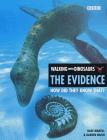 David Martill & Darren Naish
David Martill & Darren Naish
### To be written
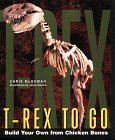 Christopher McGowan
Christopher McGowan
### To be written
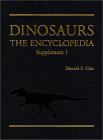 Donald F. Glut
Donald F. Glut
### To be written
 Thomas R. Holtz, Jr.
Thomas R. Holtz, Jr.Tom Holtz is probably the world's leading authority on the tyrant dinosaurs, and he also has the rare gift of explaining complex concepts in simple terms; so he's a great choice to write this kids' book on the perennial debate on how the uber-carnivore T. rex got its food. Is the Jurassic Park depiction of a swift, powerful predator correct? Or is John Horner right when he argues that rex was best suited to a scavenging lifestyle? (Horner is the author of The Complete T. Rex, but is otherwise best known for his work on parental care in duck-billed dinosaurs.)
Holtz is a careful writer, and takes pains not to pre-judge the issue. The first chapter is taken up by a couple of short stories, one describing a scavenging rex and the other describing a rex on the hunt. He shows how both of these scenarios make sense before going into a discussion of what hunting and scavenging mean (chapter 2), and how palaeontology is done (chapter 3, which includes a nice portrait of the author with a tyrannosaur skeleton.)
With this background esablished, the next two chapters consider, and dismiss, the ``evidence'' for the argument that tyrannosaurs could only scavenge and not hunt. Were its eyes too small to hunt? No, and they were positioned to give it excellent depth-perception. Were its arms too small to catch food? Yes, but many modern hunters, such as dogs and eagles, don't use their arms. And so on.
Chapters 6 and 7 look at some of these arguments in more detail, describing a fossil of a duck-billed dinosaur with healed tyrannosaur bite-marks, and analysing the proportions of rex's legs to see whether it could have run fast enough to catch its prey (yes). The last couple of chapters sum up the arguments, and conclude that, like nearly all modern carnivores, T. rex both hunted and scavenged.
The explanations are clear and compelling throughout, as you'd
expect from such a respected scientist; and the words are
complemented by Mike Skrepnick's stylish, evocative illustrations.
At the low price of $4 or £2.40, this book is excellent value for
enthusiastic kids.
 Thomas R. Holtz, Jr.; illustrated by Luis Rey
Thomas R. Holtz, Jr.; illustrated by Luis ReyHoltz and Rey's Dinosaurs raises the bar not just for all dinosaur books but for all children's books on any subject. I have never -- never -- seen a children's non-fiction book tackle its subject so head-on, in such depth, and with such approachability as this new encyclopedia does. It has something for everyone: the youngest child can enjoy Luis Rey's distinctive, dynamic illustrations; slightly older children will appreciate the descriptions of individual dinosaurs; those older still will be able to understand chapters on the history of dinosaurs, the fossilisation process, geological time and more. And even most adults will learn something from the chapter on cladistics -- surely a first in a book aimed primarily at children.
Tom Holtz is respected as one of the world's leading experts on tyrannosaurs, and more generally for his gift of explaining complex concepts as simply and clearly as possible. His prose is easy to read without being condescending, and always informative. Luis Rey is known for his characteristically colourful and feathery dinosaur art: his work could not be more different from the ``old-school'' dinosaur art of Knight and Burian: it's a welcome antidote to the dull, slow image of dinosaurs that predominated in the books of twenty or even ten years ago. That vividness is combined with a scientific rigour that is by no means universal in dinosaur art to give a new and exciting view of how dinosaurs may well have looked in life.
The book's coverage is impressively complete. An appendix gives basic information on every dinosaur named at the time of publication (about 800 genera), and the main part of the book is a sequence of chapters describing particular dinosaur groups in much more detail. For example, there are separate chapters about coelophysoids and ceratosaurs, spinosauroids, carnosaurs, primitive coelurosaurs, tyrannosauroids, ornithomimosaurs and alvarezsaurs, oviraptorosaurs and therizinosauroids, deinonychosaurs and avialans -- and that's just the theropods! Ornithischians are covered in similar detail, and while sauropodomorphs as usual draw the short straw, they do at least receive four chapters (twice as many as in The Dinosauria, 2nd edition!)
Not only that, the book is BIG -- roughly A4 in size and a good inch thick, printed on thick, glossy paper. Weighing in at a solid 1.7 kg, it has the heft of a proper encyclopedia. At the price (currently $23.90 at Amazon) it's truly absurd value for money, and sits comfortably on the shelf alongside the Glut and Currie-and-Padian encyclopedias costing five times as much.
If I had to criticise this book, then its one imperfection would the
absence of a chapter on osteology. A tour of the dinosaur skeleton,
explaining the names of the bones, how they fit together and what
they do would have been a perfect fit for the more advanced material
that's already included. But when the only thing you can criticise
about a book is that you wish there was more of it, you know you're
on to a good thing.